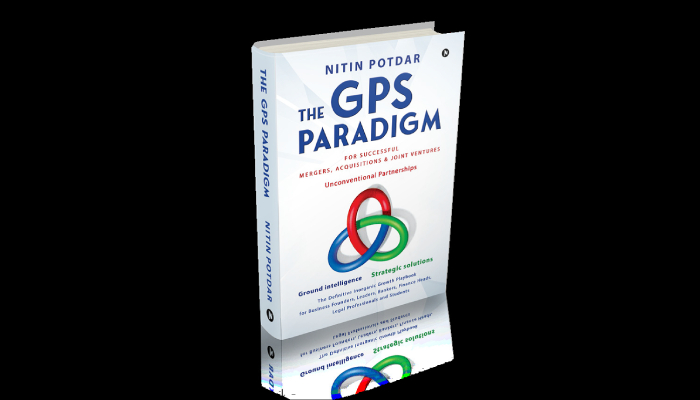
or

“Nitin Potdar’s simple (as against simplistic) approach to an intricate subject like M&As and JVs is worthy of adulation and emulation in the same breath. A charmingly inclusive book, it is arranged in a compelling sequence that makes the reading a cool breeze. I have not seen many books of this genre adorned with a seamless flow of this calibre.
Beginning with an envisioning of a tech-led future and an introduction to his unique GPS Paradigm, the reader is provided an elaboration of the dual concepts that form the core of this book – M&As and JVs. This is followed by a purposeful elucidation of how the GPS dynamic is applied to growth strategies in the living waters of business and industry. Future business leaders, Potdar forewarns us, would need to be extra-vigilant about change and transformation, as also surviving the inevitable consequences of sudden disruptions like the mayhem caused by Covid-19. The coming age will be replete with global uncertainties and rapid technological breakthroughs rooted in disruptive innovation.
But how can companies be more confident about their Merger & Acquisitions (M&As) and Joint Venture (JVs) plans and strategies? How can they soar on the wings of unflinching conviction, dogged determination, and calculated risk-taking in an environment of perpetual change and a tsunami of tech invasion? The flurry of M&As and JVs have always been the outcome of increased deregulation, globalization, and selective liberalization adopted by several countries the world over. But the growing dominance of future technologies (of which many are in nascent stages of development) calls for a more scientific and structured approach. Where does one find it and how does one adopt it?
Potdar has credible answers housed in a solution framework. Business stakeholders, both established and emerging, will have to one, necessarily go deep to secure ground intelligence, two, strike unconventional partnerships and three, create potent collaborations for developing strategic solutions in respective spheres and sectors.
These three components together constitute and activate the GPS Paradigm to help existing and future business leaders and decision makers deal with the diktats of disruptive technology and perpetual unpredictability in the course of designing and implementing their M&A and JV voyages.
In tech valuation, as Potdar rightly contends, the long-term prospects take precedence over past performance, but there is no single valuation method in vogue due to the extreme volatility and evolving nature of the tech landscape. The key valuation factors for technology businesses include number of subscribers, customer retention, and the strength of frameworks, platforms, and patents.
He takes a closer look at the valuation of key deals to help the reader grasp the peculiarities of tech valuation including Amazon’s 2009 acquisition of online shoe retailer Zappos which employed multiple methods – a comparable company analysis, DCF projections of 10-year financials, precedent transaction analysis besides considering Amazon’s trading multiples and stock price projections.


“Potdar traces the application of the GPS Paradigm in the sterling examples of several M&As and JVs structured by leading tech giants like Facebook, Google, Amazon and Jio, among other companies cited in this book. These are best read than described, so also the defining characteristics of M&As and JVs and critical issues like due diligence, deal fatigue and culture conflicts. Being a chartered accountant, I was more attracted to Nitin’s ringside views on the multifarious challenges associated with company valuations, which are invariably the bone of contention in deal after deal.”
In the case of Dell’s acquisition of virtualization player EMC, deal advisor Deloitte prescribed a value prioritization framework to spot critical areas where 20% of the prioritized opportunities represented 80% of the accretive value, thereby highlighting the criticality of a detailed valuation plan.
On the other hand, in BenQ’s acquisition of the Siemens mobile handset business, the latter’s market multiples were analyzed in conjunction with the DCF method. The acquisition lasted merely one year, given the inherent risks of resource integration that were overlooked by projected cash flows, apart from other sticky issues like culture conflicts.
Potdar lucidly highlights the fact that ground intelligence is of utmost importance in valuation methods employed for high-profile tech acquisitions. Since inaccurate revenue or trading multiples can jeopardize the deal, exhaustive due diligence is critical to arrive at a company’s fair value. Accuracy and actionability of core data, use of AI and other analytical tools to make accurate projections have become critical to valuation in modern-day business, both for tech and non-tech firms.
In phases of economic downturn, He has rightly pointed out, valuations can help companies gravitate towards striking unconventional partnerships and carry out deals not considered before. He cites the 2008 debacle as a case in point, when many forward-thinking players benefitted from lower valuations during the fag end of the crisis, which helped them accelerate businesses, pursue a broader range of deals, avail of noncash structures and fresh capital, and benefit from high leverage.
Potdar’s conclusive remarks on valuation are highly pragmatic. He highlights the fact that both parties in a M&A deal will necessarily need to rely on exhaustive valuation methods to manage risks and share rewards. They will have to scrupulously define boundary conditions for studying financial and non-financial parameters to achieve win-wins amid prevalent lows and downturns.
Last but not the least, do not miss the treasure trove of highly pragmatic court observations on this tricky subject that highlight the essence of valuation as a matter of expert opinion “where the test of fairness is whether the offer is fair to the offeree as a body and not whether it is fair to a particular shareholder in a peculiar circumstance of his own case.” Bull’s eye!
As the icing on the cake, we have an illuminating summary of Potdar’s glorious stint as a corporate lawyer who has steered several coveted M&A and JV transactions, as also his priceless tips for budding professionals, lawyers in particular.
I find this book a wholesome extension of Potdar’s lecture series on M&A and Joint Ventures on diverse platforms – whether ILS Law School, Pune, other law schools, or various fraternity meets. Beyond doubt, his GPS Paradigm is a dependable, robust, practical, and immensely energising master algorithm for achieving measurable and sustainable business success in a world thriving on disruptive innovation. This is a wholesome bouquet of actionable insights in book form for anyone working on corporate growth strategies – whether a novice student or a seasoned professional.
In his exemplary career spanning more than two decades, Nitin has acquired invaluable and actionable insights into a host of corporate growth strategies including Public & Private Mergers & Acquisitions, Cross Border Transactions, Corporate Restructuring including Asset & Share Purchase Deals, Joint Ventures, Foreign Collaborations, and PE Deals. He has developed potent and purposeful India-entry strategies for several MNCs across diverse sectors. Thanks to his inimitable solution-centric approach, Nitin has mastered the art and science of conflict resolution through a win-win for all parties without harming the cocoon of the core commercial interests. His mantra for mutually fruitful transactions is therapeutic: lucid drafting, transparent negotiations and unflinching work ethics. A keen observer of the evolution of Takeover specific laws in India as also the Insolvency Code, Nitin was an integral part of several high-profile corporate takeover negotiations, and he has successfully defended many hostile bids. He commands a rich and varied experience in facilitating PE transactions including leveraged buyout transactions and exits, as also providing strategic and domain-specific advice to investee companies. Nitin is relentless in his activism to help India make the most of her human resources and untapped potential. He has set up the #IndiaPowerTalk – a potent platform which brings together renowned global leaders across different walks of life to share their views on how to revive and revitalize the India growth story.

Lex Witness Bureau

Lex Witness Bureau

Lex Witness Bureau

For over 10 years, since its inception in 2009 as a monthly, Lex Witness has become India’s most credible platform for the legal luminaries to opine, comment and share their views. more...
Connect Us:


The Grand Masters - A Corporate Counsel Legal Best Practices Summit Series
www.grandmasters.in | 8 Years & Counting
The Real Estate & Construction Legal Summit
www.rcls.in | 8 Years & Counting
The Information Technology Legal Summit
www.itlegalsummit.com | 8 Years & Counting
The Banking & Finance Legal Summit
www.bfls.in | 8 Years & Counting
The Media, Advertising and Entertainment Legal Summit
www.maels.in | 8 Years & Counting
The Pharma Legal & Compliance Summit
www.plcs.co.in | 8 Years & Counting
We at Lex Witness strategically assist firms in reaching out to the relevant audience sets through various knowledge sharing initiatives. Here are some more info decks for you to know us better.
Copyright © 2020 Lex Witness - India's 1st Magazine on Legal & Corporate Affairs Rights of Admission Reserved